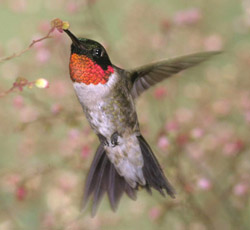Ruby-throated Hummingbird (Archilochus colubris) - Wiki Ruby-throated Hummingbird
From Wikipedia, the free encyclopedia
[Photo] Male Ruby-throated Hummingbird (Archilochus colubris) Cropped from U.S. Fish and Wildlife Service Digital Library System. Public domain USFWS
The Ruby-throated Hummingbird (Archilochus colubris), is a small hummingbird. It is the only species of hummingbird that regularly nests east of the Mississippi River in North America.
Description
The Ruby-Throated Hummingbird is 7-9 cm long with an 8-11 cm wingspan, and weighs 2-6 g. Adults are metallic green above and greyish white below, with near-black wings. Their bill is long, straight and very slender.
The adult male, shown in the photo, has an iridescent ruby red throat patch which may appear black in some lighting, and a dark forked tail. The female has a dark rounded tail with white tips and generally no throat patch, though she may sometimes have a light or whitish throat patch.
The male is smaller than the female, and has a slightly shorter beak. A molt of feathers occurs once per annum, and begins during the autumn migration.
Habitat and range
The breeding habitat is throughout most of eastern North America and the Canadian prairies, in deciduous and pine forests and forest edges, orchards, and gardens. The female builds a nest in a protected location in a shrub or tree.
The Ruby-throated Hummingbird is migratory, spending most of the winter in southern Mexico, Central America as far south as Costa Rica, and the West Indies. It breeds throughout the eastern United States, east of the 100th meridian, and in southern Canada in eastern and mixed deciduous forest.
Behavior
Ruby-throated hummingbirds are solitary. Adults of this species typically only come into contact for the purpose of mating, and both males and females of any age aggressively defend feeding locations within their territory. The aggressiveness becomes most pronounced in late summer to early fall as they fatten up for migration.
They feed frequently while active during the day and when temperatures drop, particularly on cold nights, they may conserve energy by entering hypothermic torpor.
Due to their small size, they are vulnerable to insect-eating birds and animals.
Flight
Hummingbirds have many skeletal and flight muscle adaptations which allow the bird great agility in flight. Muscles make up 25-30% of their body weight, and they have long, bladelike wings that, unlike the wings of other birds, connect to the body only from the shoulder joint. This adaptation allows the wing to rotate almost 180°, enabling the bird to fly not only forward but also straight up and down, sideways, and backwards, and to hover in front of flowers as it feeds on nectar and insects.
During hovering, ruby-throated hummingbird wings beat 55x/sec, 61x/sec when moving backwards, and at least 75x/sec when moving forward.
Diet
Nectar from flowers and flowering trees is its main food, but its diet also occasionally includes insects and tree sap taken from woodpecker drilling. It shows a slight preference for red, tubular flowers as a nectar source. The birds feed from flowers using a long extendable tongue, or catch insects on the wing.
Young birds are fed insects for protein since nectar is an insufficient source of protein for the growing birds.
Reproduction
Ruby-throated hummingbirds are thought to be polygynous. Polyandry and polygynandry may also occur. They do not form breeding pairs, and females provide all parental care.
Males arrive at the breeding area in the spring, and establish a territory before the females arrive. When the females return, males court females that enter their territory by performing courtship displays. They perform a “dive display” rising 8 to 10 feet above and 5 to 6 feet to each side of the female. If the female perches, the male begins flying in very rapid horizontal arcs less than 0.5 m in front of her. The male's wings may beat up to 200 times per second during these displays (the normal speed is 55-75 beats per second).
If the female is receptive to the male, she may give a call and assume a solicitous posture with her tail feathers cocked and her wings drooped. Preceding copulation, male and female face each other, alternately ascend about 10 feet and descend, eventually dropping to the ground and copulating.
The nest is constructed on a small, downward-sloping tree limb 10-20 feet above the ground. It is composed of bud scales, with lichen on the exterior, bound with spider's silk, and lined with plant down (often dandelion or thistle down). Old nests may be occupied for several seasons, but are repaired annually. The female constructs the nest, as the male has left by this point.
Females lay two white eggs about 12.9 by 8.5 millimeters in size, and produce 2, or occasionally 3 broods. They brood the chicks and feed them from 1 to 3 times every hour by regurgitation, usually while the female is hovering. When they are 22 to 25 days old, the young leave the nest.(0.5 x 0.3 in).
Vocalization
The vocalizations of Ruby-throated Hummingbirds are rapid, squeaky chirps, and are used primarily for threats. For example, males may vocalize to warn another male that has entered his territory.
http://en.wikipedia.org/wiki/Ruby-throated_Hummingbird
| The text in this page is based on the copyrighted Wikipedia article shown in above URL. It is used under the GNU Free Documentation License. You may redistribute it, verbatim or modified, providing that you comply with the terms of the GFDL. |
